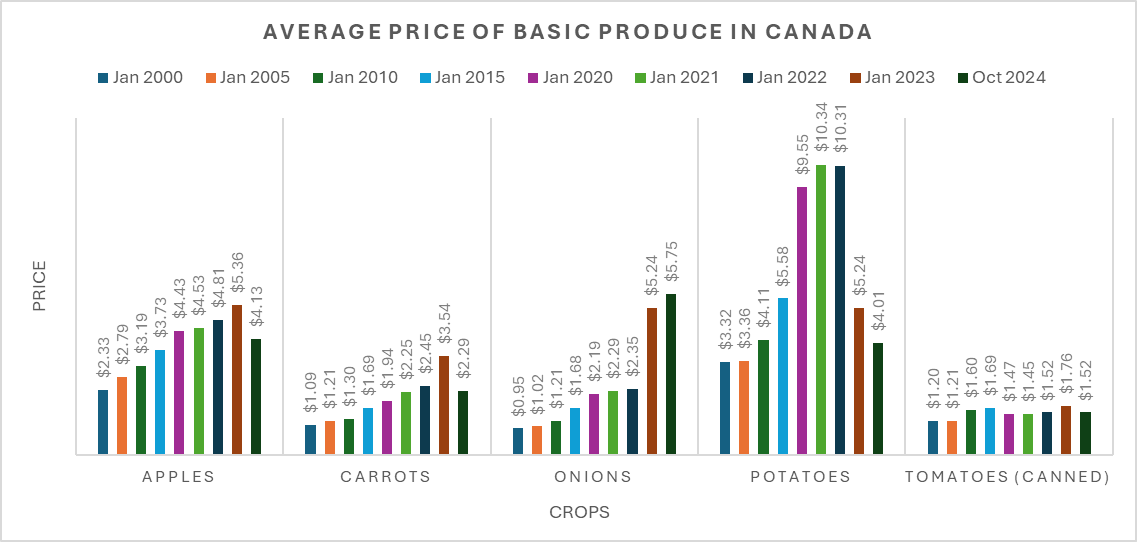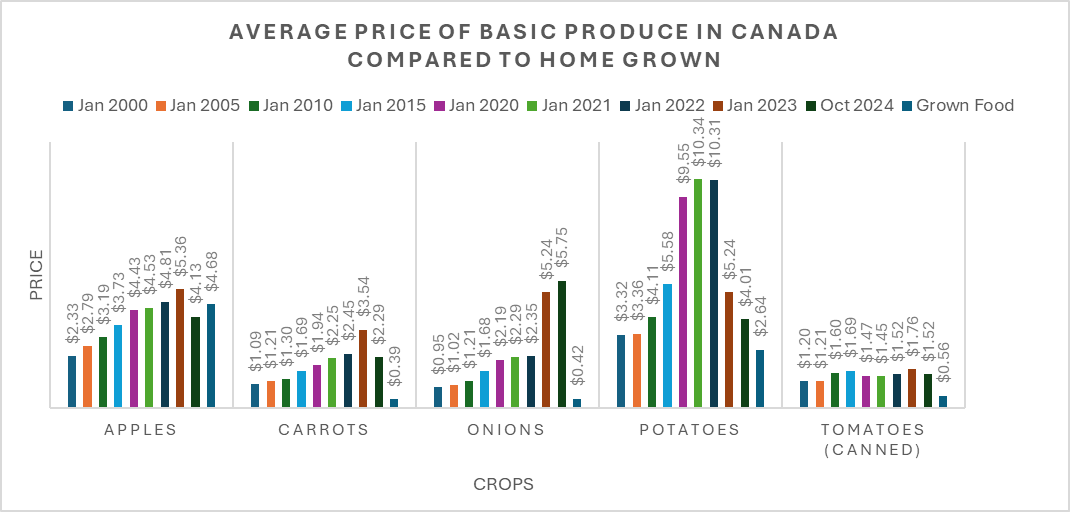This is a great topic to add to your list of New Year's resolutions: discover once and for all if it is worth it to cultivate your own food. If it is, start planning for the growing season of 2025!
If you are involved in the grocery shopping for your family, you are aware of the rising costs of fresh food, particularly since the pandemic. It seems every week there are increases in the basic foods we take for granted. Why do they cost so much? Are we imagining this cost increase or is it real? Have a look at the table and graph below to observe how some prices have changed in recent times.
Average Price of Basic Produce in Canada


These specific foods have been chosen for several reasons. They can be grown almost everywhere in Canada, there was adequate information for every column, and they are easy to grow, harvest and store. For comparison purposes, note the inflation rate for Canada during the pandemic years was 3.4% in 2021, 6.8% in 2022, and 3.88% in 2023. To say that we are living in unpredictable times is an understatement. As you can see from this table and corresponding chart, some items such as apples, carrots and canned tomatoes have increased at a more reasonable rate than onions and potatoes. Now that you have the data on the average cost of purchasing produce across Canada, how much would it cost to cultivate these crops yourself? Because we promote organic growing at Gaia College, we can also pursue organic seeds and tubers.
Average Cost of Cultivating Basic Produce in Canada


There are many variables to consider here. Soil, compost and amendments have not been accounted for where I live in Medicine Hat, for example. I would have to use the maximum amount of water; however, I can make my own compost. Perhaps you live in an area with enough moisture but may have to augment your soil. Clearly, it is not always less expensive to grow your own produce unless you have optimum growing conditions where you live and moisture for the season is plentiful, or you can collect and use rainwater. It is less expensive to buy apples until fruit trees start producing - usually that is not for at least three years. Perennial plants are an investment.
So, I ask again, is it worth it?
According to the Oxford English Dictionary, the term 'worth' is defined as:
- "worth something having a value in money, etc.
- used to recommend the action mentioned because you think it may be useful, pleasant, etc.
- important, good or pleasant enough to make somebody feel satisfied, especially when difficulty or effort is involved.
- worth something (of a person) having money and possessions of a particular value"
If it is not solely money that motivates us, what are some other actions or values of 'worth' that could justify the growing of our own food? How about these fifteen?
| Pros |
Cons |
| Improved diet |
|
| Increased exercise |
It is hard work |
| Time spent in nature |
Time |
| Reduced stress levels |
|
| Social connection (family and neighbors) |
|
| Reduce your carbon footprint |
|
| Control how your food is grown |
|
| Learning opportunities for you and your kids |
You may make mistakes |
| Superior flavor |
|
| Share the bounty |
You may grow too much |
| Convenience |
|
| Improved diet |
|
| Self sufficiency |
|
| Try new things |
|
| Support pollinators |
|
| Learn about insects |
Insects |
While you digest some of those fifteen reasons, I will share some of the reasons I grow my own food. I was raised on a mixed farm in central Alberta with five siblings. It took a giant garden to feed us and every Spring our mother would plan the garden and purchase all the seeds we would need. Then we would all help plant, maintain, harvest and eventually store the bounty.
We had a huge root cellar with a large window in the adjacent room that was completely removable. This window was removed twice a year in the Spring and the Fall. In the Fall we would haul in truckfuls of carrots, potatoes, turnips, cabbage, rutabagas, garlic and onions from the garden. And while the window was open, we would shovel in a load or two of coal for the stove. This was our heating source for the house before we had a gas furnace installed.
Once everything was stored properly, the window was buttoned back up, the garden debris was buried in a trench, and planning for the next year would commence. If we had a surplus of a certain crop, we would trade a truckful of carrots for a truckful of potatoes (for example) with a Hutterite or Mennonite colony down the road. Sometimes they would show us around their compound, and we would be amazed.
When Spring arrived the window popped back out and everything that did not get eaten was taken back out again in the opposite process and fed to the pigs! This task left us exhausted. My father believed in the ‘more is more’ philosophy.
Why plant two acres of carrots when you can plant eight acres? While we are on the carrot-rant; he used to send us out singly into the carrot field for weeding duty with a hoe and an alarm clock. He told us that when the alarm went off, we could come home. I think it was only an hour or two, but I was too young to know. I found out only recently that my siblings went out there and napped in the carrot fields! I may have been the only one weeding those eight acres of carrots.
The same ‘more is more’ philosophy applied to most other vegetables and fruits. Potatoes and strawberries come to mind first. When we hauled the unused potatoes out of the root cellar in the Spring, we used them for seed potatoes, as they had shriveled up nicely. Even though we had more than enough, our father thought it would be best if we cut these up to make MORE tuber cuttings. “Because you don’t want to run out - that would be embarrassing”.
He had crop rotation down to an art: I think he may have invented crop rotation. Fields of carrots became fields of cabbage, then potatoes, then strawberries. One year he decided the goats should be where the strawberries were, and we had to transplant acres of them to another field (the strawberries, not the goats). Most farmers use crop rotation as a tool to control pests and to protect the soil; I think my father used crop rotation to keep his children occupied and his goats confused.
Obviously, things have changed a LOT since I was a young girl. However, feeding our families remains a top priority for everyone. All the fifteen items listed above in the ‘Pro’s’ column were addressed when I was growing up with fresh food from a garden; I just did not know to appreciate it at the time.
If growing food sounds interesting to you, consider signing up for some courses at Gaia College today, and get started on your own list of pros!
Annette Vierling
Sources:
Australia, G. o. (2019, 05 07). Irrigating carrots for profit and environmental management. Retrieved from Department of Primary Industries and Regional Development's Agriculture and Food: https://www.agric.wa.gov.au/water-management/irrigating-carrots-profit-and-environmental-management?nopaging=1
Barker, B. (2010, 02 10). Understand crop water use to guide management. Retrieved from Top Crop Manager: https://www.topcropmanager.com/understand-crop-water-use-to-guide-management-4937/
Canada, S. (2022, 03 16). Monthly average retail prices for food and other selected products. Retrieved from Statistics Canada: https://www150.statcan.gc.ca/t1/tbl1/en/tv.action?pid=1810000201
Canada, S. (2024, 11 20). Food Price Data Hub. Retrieved from Statistics Canada: https://www.statcan.gc.ca/en/topics-start/food-price
Canada, S. (2024, 12 04). Monthly average retail prices for selected products. Retrieved from Statistics Canada: https://www150.statcan.gc.ca/t1/tbl1/en/tv.action?pid=1810024501
Center, W. A. (2018, 04 02). Apple Orchard Irrigation. Retrieved from Montana State University: https://agresearch.montana.edu/warc/guides/apples/Apple_Irrigation.html
Dictionary, O. L. (2025, 01 01). Oxford Learners Dictionary. Retrieved from Oxford Learners Dictionary: https://www.oxfordlearnersdictionaries.com/definition/english/worth_1?q=worth
Hat, C. o. (2024, 01 01). 2024 Utility Rates. Retrieved from City of Medicine Hat: chrome-extension://efaidnbmnnnibpcajpcglclefindmkaj/https://www.medicinehat.ca/en/home-property-and-utilities/resources/Documents/Utility-Rate-Brochures/Utility-Rate-Brochures-2024/CMH-2024-Utility-Rates.pdf
Market, U. R. (2022, 05 25). The top 5 benefits of growing your own vegetables. Retrieved from Urban Roots Garden Market: https://urbanrootsgardenmarket.ca/the-top-5-benefits-of-growing-your-own-vegetables/
Nations, F. a. (2021). Land and Water - information on water relations and water management of onion. Retrieved from Food and Agriculture Organization of the United Nations: https://www.fao.org/land-water/databases-and-software/crop-information/onion/en/
O'Neill, A. (2024, October). Canada: Inflation rate from 1987 to 2029. Retrieved from Statistica: https://www.statista.com/statistics/271247/inflation-rate-in-canada/
Ontario, G. o. (2008, 04). Irrigation scheduling for tomatoes. Retrieved from Government of Ontario: https://www.ontario.ca/page/irrigation-scheduling-tomatoes#:~:text=An%20average%20cultivar%20requires%20about,total%20from%20May%20to%20September.
Perfect, P. (2022, 07 11). 10 Reasons Why You Should Start Growing Your Own Food. Retrieved from Planet Perfect: https://plantperfect.com/why-you-should-start-growing-your-own-food/
Seeds, W. C. (2024, 12 30). Vegetable seeds. Retrieved from West Coast Seeds: https://www.westcoastseeds.com/collections/vegetable-seeds
Shahbandeh, M. (2024, 11 29). Statista. Retrieved from Food price inflation in Canada - statistics & facts: https://www.statista.com/topics/9659/food-price-inflation-in-canada/#topicOverview
Wimmer, L. (2022, 07 22). Dig into the benefits of gardening. Retrieved from Mayo Clinic Health System: https://www.mayoclinichealthsystem.org/hometown-health/speaking-of-health/dig-into-the-benefits-of-gardening